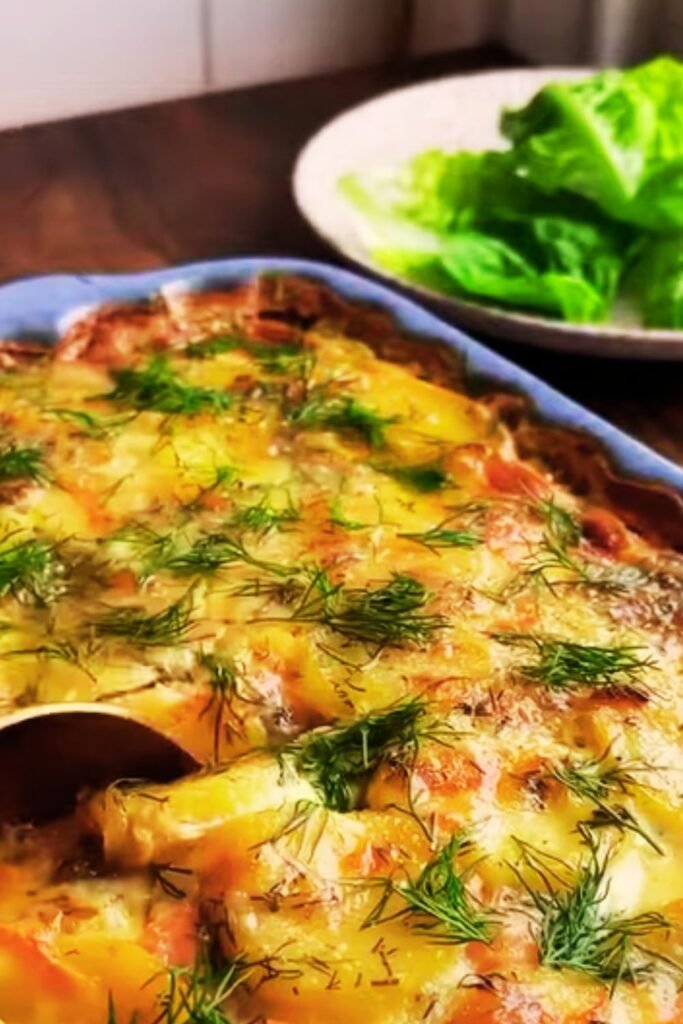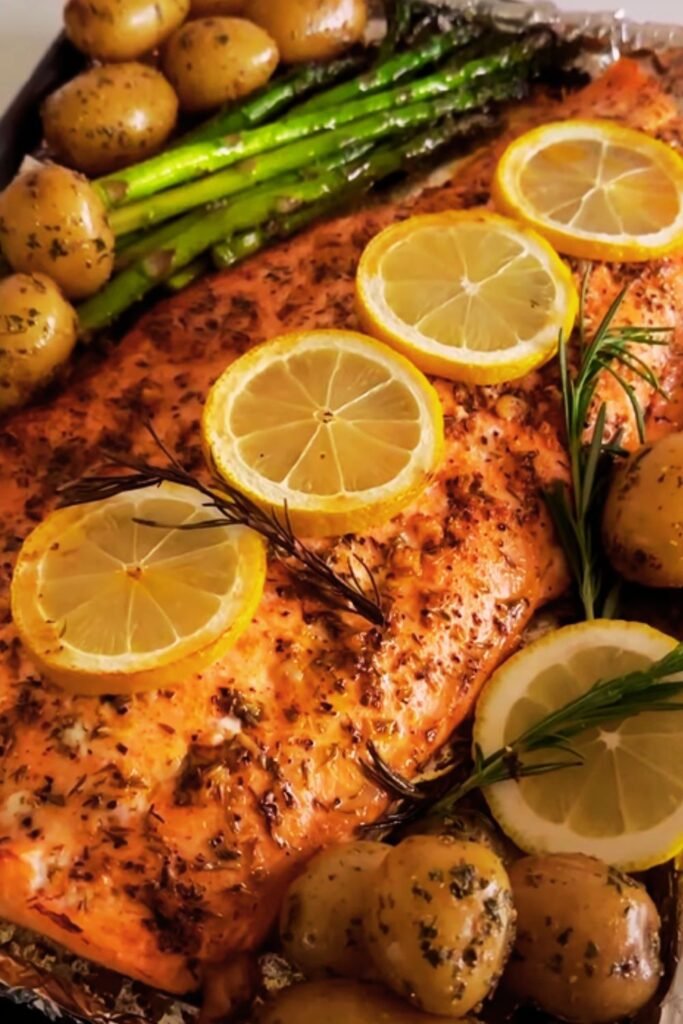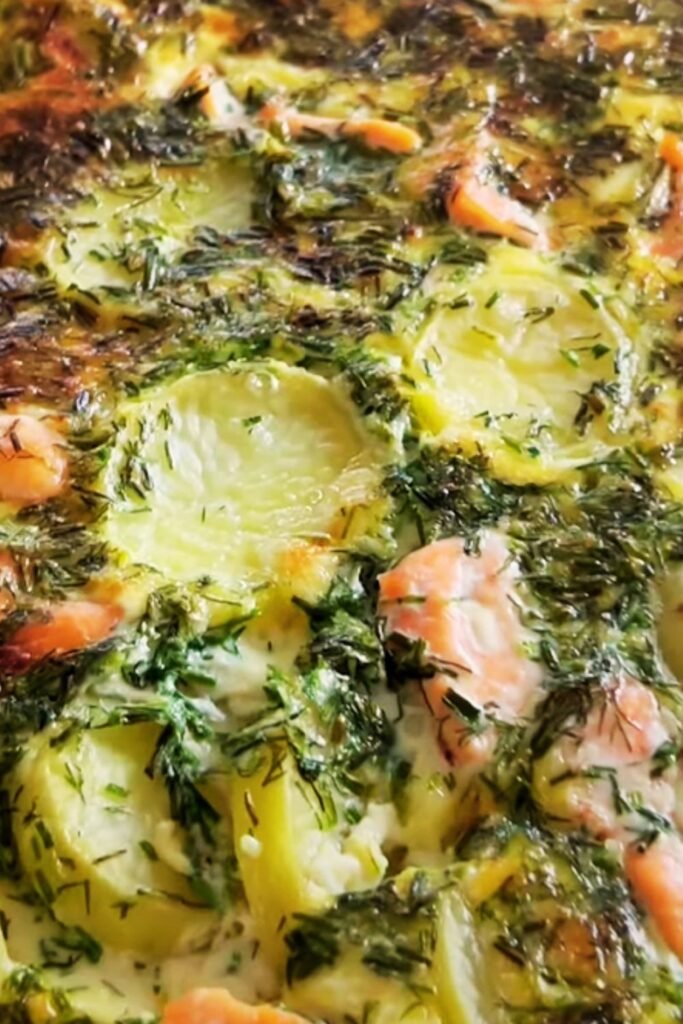Growing up, I never imagined that a simple combination of salmon, potatoes, and cream could create such culinary magic. My first encounter with Laxpudding happened during a chilly Stockholm evening, and I was immediately captivated by its comforting warmth and sophisticated simplicity. This traditional Swedish dish represents everything I love about Nordic cuisine: it’s hearty, elegant, and deeply rooted in seasonal ingredients.
Laxpudding, literally translating to “salmon pudding,” is far more than its humble name suggests. This beloved Swedish casserole has graced family tables for generations, transforming simple pantry staples into a dish worthy of both everyday dinners and special occasions. What makes this recipe particularly special is how it celebrates the marriage between Sweden’s abundant salmon and the country’s love affair with potatoes.
Understanding Laxpudding: A Nordic Classic
Laxpudding : A traditional Swedish layered casserole combining fresh or smoked salmon, thinly sliced potatoes, onions, and a rich cream-based custard, baked until golden and bubbling.
Gratäng : The Swedish term for casseroles or gratins, typically featuring layered ingredients bound with cream or milk and baked until set.
Fisk och Potatis : The Swedish culinary tradition of pairing fish with potatoes, forming the backbone of many traditional dishes.
The beauty of Laxpudding lies in its versatility. I’ve prepared it with fresh Atlantic salmon during summer months and switched to smoked salmon during winter, each version offering its own distinct character. The dish embodies the Swedish concept of “lagom” – not too much, not too little, but just right.
The Cultural Heritage Behind This Dish
Laxpudding emerged during the 18th century when Swedish cooks began experimenting with layered casseroles. The dish gained popularity among middle-class families because it stretched expensive salmon into a filling meal that could feed large households. Fishermen’s wives particularly appreciated how it transformed leftover fish into something extraordinary.

During my travels through Skåne and Västergötland, I discovered that every Swedish province has its own variation. Some regions add dill, others incorporate different types of fish, and coastal areas often include a touch of cream mixed with fish stock. These regional differences reflect Sweden’s diverse culinary landscape and the resourcefulness of its home cooks.
Essential Ingredients for Perfect Laxpudding
Creating authentic Laxpudding requires understanding each ingredient’s role in building layers of flavor. I’ve experimented with countless variations, and these ingredients consistently deliver the best results:
Primary Components
| Ingredient | Quantity | Purpose | Quality Tips |
|---|---|---|---|
| Fresh Salmon Fillet | 800g | Main protein | Choose wild-caught when possible, skin removed |
| Waxy Potatoes | 1.2kg | Structure base | Yukon Gold or fingerlings work best |
| Yellow Onions | 3 medium | Flavor foundation | Sweet onions add depth |
| Heavy Cream | 500ml | Custard base | 35% fat content minimum |
| Whole Milk | 250ml | Custard dilution | Full-fat only |
| Large Eggs | 4 | Binding agent | Room temperature |
| Fresh Dill | 4 tablespoons | Aromatic herb | Chopped fine |
| Butter | 75g | Richness | Unsalted European-style |
Seasoning Profile
| Seasoning | Amount | Application | Notes |
|---|---|---|---|
| Sea Salt | 2 teaspoons | Throughout layers | Flaky sea salt preferred |
| White Pepper | 1 teaspoon | Custard mixture | More delicate than black |
| Nutmeg | 1/4 teaspoon | Cream base | Freshly grated |
| Bay Leaves | 2 leaves | Aromatic depth | Remove before serving |
The key to exceptional Laxpudding lies in ingredient quality. I always choose wild-caught salmon when available, as its firmer texture and richer flavor create a more satisfying dish. The potatoes should be waxy varieties that hold their shape during baking – I’ve learned this lesson through several disappointing attempts with russet potatoes that turned to mush.
Step-by-Step Preparation Guide
Initial Preparation (30 minutes)
My approach to Laxpudding emphasizes proper preparation, which ensures even cooking and optimal flavor development. I begin by organizing all ingredients and preheating the oven to 180°C (350°F).
Potato Preparation:
- Wash and peel potatoes thoroughly
- Slice into 3mm thick rounds using a mandoline or sharp knife
- Soak sliced potatoes in cold water for 15 minutes
- Pat completely dry with clean kitchen towels
Salmon Preparation:
- Remove any remaining skin and pin bones
- Cut into 2cm cubes
- Season lightly with salt and set aside
- Allow to come to room temperature

Creating the Perfect Custard Base
The custard base transforms this dish from simple layered ingredients into something extraordinary. I’ve refined this technique through years of practice:
- Whisk eggs thoroughly in a large bowl until completely smooth
- Gradually add cream while whisking continuously to prevent curdling
- Incorporate milk slowly maintaining constant motion
- Season generously with salt, white pepper, and nutmeg
- Strain mixture through fine-mesh sieve to remove any lumps
The custard should coat the back of a spoon lightly. If it’s too thin, add an extra egg yolk; if too thick, thin with additional milk.
Assembly Technique
Proper layering creates the signature texture that makes Laxpudding so appealing. I use a deep, buttered 23x33cm baking dish for optimal results.
Layer 1 – Foundation:
- Arrange half the potato slices in overlapping rows
- Brush with melted butter
- Season with salt and pepper
Layer 2 – Protein:
- Distribute salmon cubes evenly
- Scatter chopped dill over salmon
- Add thinly sliced onions
Layer 3 – Completion:
- Layer remaining potatoes in attractive pattern
- Brush with remaining butter
- Pour custard mixture slowly over entire dish
The custard should reach about 3/4 up the sides of the dish. I always reserve a small amount to add halfway through baking if needed.
Baking and Timing Perfection
Achieving the perfect Laxpudding requires understanding how different elements cook at varying rates. My baking method ensures everything reaches doneness simultaneously:
Temperature Control
| Phase | Temperature | Duration | Visual Cues |
|---|---|---|---|
| Initial Bake | 180°C (350°F) | 25 minutes | Edges begin setting |
| Covered Phase | 160°C (325°F) | 30 minutes | Custard thickens |
| Final Browning | 190°C (375°F) | 10-15 minutes | Golden top forms |
I cover the dish with foil during the middle phase to prevent over-browning while ensuring the center cooks through. The final uncovered phase creates that beautiful golden crust that makes Laxpudding so visually appealing.
Doneness Indicators
Perfect Laxpudding exhibits several key characteristics:
- Custard is set but still slightly jiggly in center
- Top potatoes are golden brown and crispy edges
- Knife inserted in center comes out mostly clean
- Internal temperature reaches 75°C (165°F)

Serving and Presentation
Laxpudding benefits from a 10-minute rest after baking, allowing the custard to firm up for cleaner slicing. I serve it family-style, cutting generous squares that showcase the beautiful layers.
Traditional Accompaniments
Swedish tradition pairs Laxpudding with simple, clean flavors that complement rather than compete with the dish’s richness:
- Cucumber Salad (Gurksallad): Paper-thin cucumbers dressed with white vinegar, sugar, and fresh dill
- Lingonberry Sauce: The tartness cuts through the cream beautifully
- Simple Green Salad: Mixed greens with light vinaigrette
- Rye Crispbread: Provides textural contrast
- Pickled Beets: Traditional Swedish side that adds color and acidity
Modern Serving Suggestions
I’ve also enjoyed Laxpudding with contemporary accompaniments:
- Arugula salad with lemon dressing
- Roasted asparagus with herbs
- Steamed broccoli with almonds
- Fresh herb garnish (dill, chives, parsley)
Nutritional Profile and Dietary Considerations
Understanding Laxpudding’s nutritional content helps with meal planning and dietary accommodations:
Nutritional Breakdown (Per Serving, Serves 8)
| Nutrient | Amount | % Daily Value | Health Benefits |
|---|---|---|---|
| Calories | 485 | 24% | Substantial meal portion |
| Protein | 28g | 56% | High-quality complete protein |
| Fat | 32g | 49% | Healthy omega-3 fatty acids |
| Carbohydrates | 22g | 7% | Complex carbs from potatoes |
| Calcium | 245mg | 25% | Bone health support |
| Vitamin D | 15.2mcg | 76% | From salmon and eggs |
| Potassium | 890mg | 19% | Heart health support |
The salmon provides exceptional omega-3 fatty acids, supporting heart and brain health. Potatoes contribute vitamin C and potassium, while the dairy components add calcium and vitamin D.
Dietary Modifications
Lactose-Free Version: Replace cream and milk with lactose-free alternatives or use coconut cream mixed with fish stock for richness without dairy.
Lower-Fat Alternative: Substitute half the cream with fish stock and use milk instead of heavy cream. The result is lighter but still satisfying.
Gluten-Free Consideration: Laxpudding is naturally gluten-free, making it suitable for those with celiac disease or gluten sensitivity.
Storage and Reheating Guidelines
Proper storage maintains Laxpudding’s quality for several days, making it excellent for meal preparation:
Storage Methods
| Method | Duration | Temperature | Quality Notes |
|---|---|---|---|
| Refrigerated | 3-4 days | 4°C (39°F) | Cover tightly with foil |
| Frozen | 2-3 months | -18°C (0°F) | Texture changes slightly |
| Portioned | 5 days | 4°C (39°F) | Individual servings |
Reheating Techniques
Oven Method (Preferred):
- Preheat oven to 160°C (325°F)
- Cover with foil to prevent drying
- Heat 20-25 minutes until warmed through
- Remove foil last 5 minutes for crispy top
Microwave Method: Heat individual portions on 70% power for 2-3 minutes, checking frequently to prevent overcooking.
Troubleshooting Common Issues
Through years of making Laxpudding, I’ve encountered and solved various challenges:
Watery Custard:
- Cause: Too much liquid or insufficient eggs
- Solution: Add extra egg yolk or reduce liquid slightly
Curdled Mixture:
- Cause: Temperature shock when combining ingredients
- Solution: Temper eggs slowly with warm cream
Soggy Potatoes:
- Cause: Excess moisture or insufficient drying
- Solution: Always pat potatoes completely dry before layering
Overcooked Salmon:
- Cause: Too high temperature or excessive baking time
- Solution: Use lower temperature and check frequently
Uneven Browning:
- Cause: Oven hot spots or improper rack position
- Solution: Rotate dish halfway through baking
Seasonal Variations and Creative Adaptations
Laxpudding’s adaptability makes it perfect for seasonal modifications:
Spring Variation
Add fresh peas and asparagus tips between layers for vibrant color and spring flavors.
Summer Version
Incorporate fresh herbs like chervil and tarragon, plus thin zucchini slices for lighter texture.
Autumn Adaptation
Include roasted root vegetables like parsnips or turnips for earthy depth.
Winter Enhancement
Use smoked salmon and add a touch of horseradish to the custard for warming spice.
Q&A Section
Q: Can I make Laxpudding ahead of time? Yes, absolutely! I often assemble the entire dish the night before serving. Cover tightly and refrigerate, then add an extra 10-15 minutes to the baking time since you’re starting with a cold dish.
Q: What’s the best type of salmon to use? I prefer wild-caught Atlantic or Pacific salmon for the best flavor and texture. Farm-raised salmon works well too, though it may be slightly less firm. Smoked salmon creates a different but equally delicious variation.
Q: Why did my custard separate during baking? Custard separation usually occurs from too high heat or temperature shock. Always bake at moderate temperatures and ensure ingredients are at similar temperatures before combining.
Q: Can I substitute other fish for salmon? Certainly! I’ve made excellent versions with cod, haddock, or even mixed seafood. Adjust cooking times based on the fish’s thickness and density.
Q: How do I prevent the top from becoming too brown? Cover with foil if browning too quickly, and consider lowering the oven temperature slightly. The dish should cook gently to allow even heat penetration.
Q: Is it possible to make individual portions? Yes! Use ramekins or small baking dishes, reducing cooking time to about 25-30 minutes total. This makes elegant presentations for dinner parties.
Q: What causes the layers to become muddled during baking? Usually this happens when the custard mixture is too thin or when ingredients aren’t properly drained. Ensure potatoes are completely dry and the custard has proper consistency.
Q: Can I freeze Laxpudding successfully? While possible, freezing changes the texture somewhat. The custard may become slightly grainy, and potatoes can become softer. It’s best enjoyed fresh or refrigerated for a few days.
This traditional Swedish Laxpudding has become one of my most requested recipes, bringing Nordic comfort to dinner tables around the world. Its combination of simple ingredients and sophisticated technique creates something truly special – a dish that honors tradition while satisfying modern palates. Whether you’re exploring Scandinavian cuisine or simply seeking a new comfort food favorite, Laxpudding delivers warmth, nutrition, and unforgettable flavor in every spoonful.